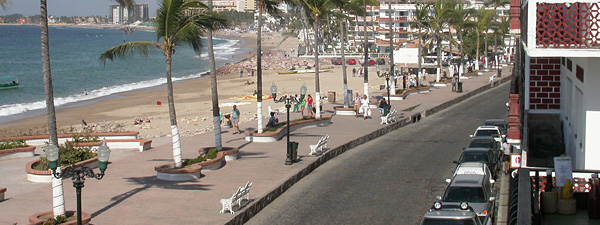 |
 |
 |
 News from Around Banderas Bay | December 2007 News from Around Banderas Bay | December 2007  
What Makes Puerto Vallarta Quaint?
 Jim Scherrer - PVNN Jim Scherrer - PVNN


| Perhaps Vallarta is no longer a sleepy little Mexican fishing village, but due to its abundance of granite cobblestone streets, it does retain its status as being one of the most beautifully quaint resort destinations in the world.

|
Quaint, as defined by Webster and others, means unusual or old fashioned in a pleasing way, with a charming old fashioned quality, or oddly picturesque.

Some will say that Puerto Vallarta is a quaint or picturesque city due to the thousands of whitewashed villas, condos, and other buildings nestled among the Sierra Madre hillsides surrounding Banderas Bay along the Pacific Ocean coastline.

Others might attribute the quaintness of Vallarta to the many nearby inlets and coves where the old fishing pangas are docked with their resident pelicans waiting for dinner or perhaps to the beach vendors selling their colorful blankets, sculptures, and artwork.

Viewing the crafts of local artisans while strolling along the seafront promenade, referred to as the Malecon, or visiting the hundreds of curio and souvenir shops gives many tourists the feeling of being in a quaint little Mexican fishing village.

For others, the optimum feeling of being in a quaint little Mexican village or relaxing in Paradise is derived from sipping Margaritas or Cervezas in one of the many beachfront cantinas or restaurants, while watching the magnificent sunsets.

Although the city has reached the size of St. Louis with 350,000 inhabitants, it still possesses the atmosphere of a small village where everyone seems to know each other. Residents often consider Vallarta to be charming in an old-fashioned way due to the friendliness of its people; where everyone that you meet is readily open to new friendships as recently revealed when surveyed readers of Conde Nast magazine voted Puerto Vallarta the friendliest resort destination in the world.

With the above being said, some of us tend to find the quaintness of Vallarta to be most closely associated with granite; yes, granite!

Located on the same latitude as Hawaii, Puerto Vallarta lies at the extreme western end of the Mexican Trans-Volcanic Axis range; a mountain range extending across the entire country of Mexico consisting of 38 volcanoes that were formed during the late-Pleistocene age.

Twelve of these volcanoes are still considered to be active, i.e., they have erupted at least once during the past 10,000 years, however only a few of these remain quite active at this time. When they were originally formed, they spewed their molten lava or magma containing all sorts of igneous materials throughout the area, with granite being one of the most commonly formed igneous rocks.

The entire region of central Mexico, including Puerto Vallarta and Banderas Bay, is laden with granite; so much so, that granite counter tops are more common in Vallarta than are those of Formica! In addition to huge granite rocks, there are obviously millions of smaller granite rocks in the area; many of which lie at the bottom of the ocean, bay, and in river beds. As these smaller underwater granite rocks are tossed and turned by wave action over long periods of time, they are reduced in size, their edges are smoothly rounded off, and they become cobblestones. During the evenings in Vallarta when the surf is active, you can hear the rumbling sound of millions of cobblestones as they move in and out with the wave action.

These 3" to 10" granite cobblestones have a myriad of usages; commonly being associated with the construction of buildings, walls, and fences, and most importantly, the paving of roads.

Although there is no shortage of road construction materials in Mexico with CEMEX, headquartered in Monterrey, Mexico, being the world's largest supplier of building materials and the world's third largest cement producer, cobblestone is still the material of choice for road building in Puerto Vallarta. The hard granite cobblestone paved roads provide flexibility to traffic and earth movement, are permeable to water, and are simple to repair.

Granted, they're not the best on shock absorbers and you can forget about riding your bicycle around town! Residents of Vallarta are accustomed to the uneven road surfaces but as a fair warning to first time visitors, please use caution when strolling through the city; it's relatively easy to sprain an ankle if you're not paying attention to where you're walking on the cobblestone streets.

Perhaps more significantly than the benefits listed above, cobblestone roads preserve the quaintness of Vallarta. With more than 90% of the local streets and roads paved with cobblestones, it is probably the first thing that most locals as well as tourists think of when considering the qualities that make Vallarta one of the most beautiful resort destinations in the world.

With all the conveniences of modern day life available in Vallarta, including satellite TV, high speed internet service, and internet based telecommunications, we still hear the familiar sound of horses' hooves clip clopping on the cobblestone street in front of our mountainside villa as the ranchers from high on the mountain carry their goods to town on a daily basis.

Peering over the poolside terrace, we see the cobblestone streets below that wind their way down the mountain, all appearing to terminate near the bay. What a glorious site; a 180° view of Banderas Bay, El Centro, the native flora and fauna of the Sierra Madres, the whitewashed and pastel colored villas below with their red tile roofs, and yes, the cobblestone streets winding between them. It just doesn't get much more picturesque or quainter than that!

In summarizing, among the many unique characteristics that Vallarta has to offer, its picturesque cobblestone streets have to be at or near the top of everyone's list. Perhaps Vallarta is no longer a sleepy little Mexican fishing village, but due to its abundance of granite cobblestone streets, it does retain its status as being one of the most beautifully quaint resort destinations in the world.
 The founder of Puerto Vallarta Real Estate Buyers' Agents (PVREBA), Jim Scherrer is a retired entrepreneur who has owned property in Puerto Vallarta for 24 years. Utilizing his experience and extensive knowledge of the area, Jim has written a series of informative articles about travel to and retirement in Puerto Vallarta, which you can read on his website at PVREBA.com. The founder of Puerto Vallarta Real Estate Buyers' Agents (PVREBA), Jim Scherrer is a retired entrepreneur who has owned property in Puerto Vallarta for 24 years. Utilizing his experience and extensive knowledge of the area, Jim has written a series of informative articles about travel to and retirement in Puerto Vallarta, which you can read on his website at PVREBA.com.

Click HERE for more articles by Jim Scherrer | 
 | |
 |



